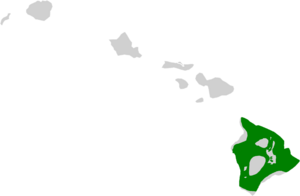ʻAkiapolaʻau facts for kids
Quick facts for kids ʻAkiapōlāʻau |
|
|---|---|
 |
|
| Conservation status | |
| Scientific classification | |
| Genus: |
Hemignathus
|
| Species: |
wilsoni
|
 |
|
| Synonyms | |
|
Hemignathus munroi (Pratt, 1979) |
|
The ʻakiapōlāʻau (pronounced ah-kee-ah-POH-LAH-OW) is a special bird found only on the island of Hawaii. It is a type of Hawaiian honeycreeper. This bird lives in both dry and wet rainforests on the mountains. It's the only bird on the island that acts like a woodpecker.
The ʻakiapōlāʻau is about 5.5 inches (14 cm) long. It has a very unique, curved beak. This bird is a bit pudgy. It has a whitish belly and tail, black legs, and a yellow chest. Its head is orangish, with a black mask around its eyes and a black bill. Its wings are gray-black.
Male ʻakiapōlāʻau birds sing a loud, short pit-er-ieu or a fast warba-warba. They also make other sounds like a whistle that goes up, a short cheedle-ee warble, and a quick sweet. This bird might be the last of its kind in its group (genus). Other similar birds, like the Kauai nukupuʻu and Maui nukupuʻu, have disappeared. The ʻakiapōlāʻau is special because it feeds like a woodpecker, mostly eating insects.
Contents
Where the ʻAkiapōlāʻau Lives
The ʻakiapōlāʻau mostly lives in very old, wet forests. These forests are found in areas like Kaʻū and Hamakua on Hawaii Island. The main trees in its home are Koa (Acacia koa) and ʻōhiʻa lehua (Metrosideros polymorpha).
Tiny insects called mosquitoes carry diseases that hurt these birds. Because of this, the ʻakiapōlāʻau can only live at certain heights, between 1,300 and 2,100 metres (4,300 and 6,900 ft) up the mountains. It used to live in drier forests on Mauna Kea mountain. But that group of birds disappeared in 2002.
What the ʻAkiapōlāʻau Eats
This bird loves to eat insects that hide inside tree branches. It also drinks nectar from flowers that fit its curved bill. Sometimes, it looks for small bugs on the forest floor, where there's lots of natural growth.
The ʻakiapōlāʻau uses its long, strong bill to peck holes in tree bark. This helps it find hidden insect larvae. Then, it uses its thin upper bill to pull out the meal. Its lower bill helps it crush the insects before eating them.
Reproduction and Life Cycle
Scientists have found a few nests of the ʻakiapōlāʻau. Most nests usually have only one egg. Sadly, only about half of these eggs grow into adult birds. This bird also reproduces slowly. It only lays eggs every other year.
Protecting the ʻAkiapōlāʻau
The ʻakiapōlāʻau was common many years ago. But its numbers started to drop. One big problem is rats. Rats eat the birds' eggs, which means fewer new birds are born.
The bird's population is now split into small groups. The smallest group has only three birds. Another group has about twenty birds, and a slightly larger one has forty-four. The biggest group has around 1,097 birds, but even this number seems to be getting smaller. The group of three birds is especially at risk.
The ʻakiapōlāʻau is also threatened by loss of habitat. This happens when its forest homes are cut down. New animals like rats, cats, and dogs also hunt these birds and eat their food.
Some alien plants, like the strawberry guava, are also a problem. They grow quickly and take over the space needed by the koa and ʻōhiʻa trees. These are the trees the ʻakiapōlāʻau depends on. Pigs also cause damage. They make muddy holes called wallows. These wallows can hurt tree roots and create places for mosquitoes to breed. The mosquitoes carry diseases that the birds cannot fight off.
Because of its small and separated groups, low numbers, slow reproduction, and loss of home, the ʻakiapōlāʻau was put on the endangered species list in 1967. People are working hard to help this bird. They are planting many new trees and trying to remove wild animals like pigs. They also want to start a group of these birds in zoos to help them breed safely. Scientists are collecting information about the bird's life to help with these plans. However, it has been hard to get eggs or adult birds to start a breeding program in captivity.
See also


